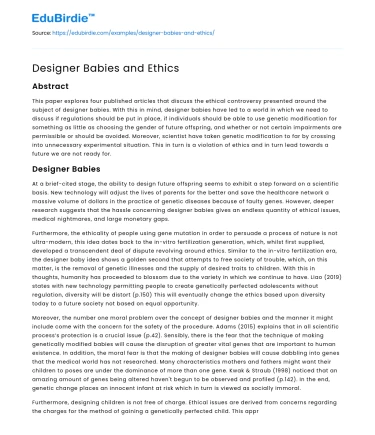Table of contents
- Abstract
- Designer Babies
- References
Abstract
This paper explores four published articles that discuss the ethical controversy presented around the subject of designer babies. With this in mind, designer babies have led to a world in which we need to discuss if regulations should be put in place, if individuals should be able to use genetic modification for something as little as choosing the gender of future offspring, and whether or not certain impairments are permissible or should be avoided. Moreover, scientist have taken genetic modification to far by crossing into unnecessary experimental situation. This in turn is a violation of ethics and in turn lead towards a future we are not ready for.
Designer Babies
At a brief-cited stage, the ability to design future offspring seems to exhibit a step forward on a scientific basis. New technology will adjust the lives of parents for the better and save the healthcare network a massive volume of dollars in the practice of genetic diseases because of faulty genes. However, deeper research suggests that the hassle concerning designer babies gives an endless quantity of ethical issues, medical nightmares, and large monetary gaps.
Furthermore, the ethicality of people using gene mutation in order to persuade a process of nature is not ultra-modern, this idea dates back to the in-vitro fertilization generation, which, whilst first supplied, developed a transcendent deal of dispute revolving around ethics. Similar to the in-vitro fertilization era, the designer baby idea shows a golden second that attempts to free society of trouble, which, on this matter, is the removal of genetic illnesses and the supply of desired traits to children. With this in thoughts, humanity has proceeded to blossom due to the variety in which we continue to have. Liao (2019) states with new technology permitting people to create genetically perfected adolescents without regulation, diversity will be distort (p.150) This will eventually change the ethics based upon diversity today to a future society not based on equal opportunity.
Moreover, the number one moral problem over the concept of designer babies and the manner it might include come with the concern for the safety of the procedure. Adams (2015) explains that in all scientific process’s protection is a crucial issue (p.42). Sensibly, there is the fear that the technique of making genetically modified babies will cause the disruption of greater vital genes that are important to human existence. In addition, the moral fear is that the making of designer babies will cause dabbling into genes that the medical world has not researched. Many characteristics mothers and fathers might want their children to poses are under the dominance of more than one gene. Kwak & Straub (1998) noticed that an amazing amount of genes being altered haven't begun to be observed and profiled (p.142). In the end, genetic change places an innocent infant at risk which in turn is viewed as socially immoral.
Furthermore, designing children is not free of charge. Ethical issues are derived from concerns regarding the charges for the method of gaining a genetically perfected child. This approach is much like the Vitro-fertilization which do not come at a less expensive fee and commonly charge around thousands of bucks. Lemonick & Bjerkile (1999) study determined the following:
The ethical difficulty is based upon the fact that if designer infants grow to be a reality, the costly rate of the procedure will create a new social division between folks that can come up with the money for the expensive process and those who can’t. Consequently, the richer civilians might be capable of having offspring which have the suited trends while the lower class would now not be able to have that choice. (p.199)
With this in thoughts, the end result of a world ruled by genetically perfected rich human beings would exacerbate the current problem of the widening gap between the rich and the poor. Therefore, we cannot create a new social distinction that puts improved humans on one side and unenhanced humans on the other side. This leads to the affluent having all the opportunities to themselves.
All in all, the evaluation of morals concerning designer babies will continue to rise as more innovation and procedures on human genetic modification adjustment enhance. While there is a need to assess all the greater possibilities that designer babies offer it is important to understand the consequences the points in this essay present. While there seems to be a mass amount of study done on whether there will be long term effects of undergoing genetic design, it is apparent that this issue will continue to elicit debate and controversy in society concerning its ethical side, medical implications, and costly price tag.
References
- Adams, J. U. (2015). Manipulating the Human Genome: Are scientist going to far? CQ Researcher, 25(23), 529-552.
- Lemonick, M. D., Bjerkile, D., Park, A., & Thompson, D. (1999). Designer Babies. (Cover story). TIME Magazine, 153(1), 64.
- Liao, S. (2019) Designing humans: A rights approach. Retrieved from EBSCO eBook and Audiobook Collection database. Embodiment. Retrieved from EBSCO eBook and Audiobook Collection database
- Kwak, J., & Straub, S. (1998). Customized Progeny. Newsweek, 132(22), 18.






 Stuck on your essay?
Stuck on your essay?

